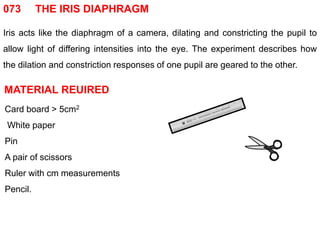073 the iris diaphragm
- 1. 073 THE IRIS DIAPHRAGM Iris acts like the diaphragm of a camera, dilating and constricting the pupil to allow light of differing intensities into the eye. The experiment describes how the dilation and constriction responses of one pupil are geared to the other. MATERIAL REUIRED Card board > 5cm2 White paper Pin A pair of scissors Ruler with cm measurements Pencil.
- 2. In the centre of a piece of thin card about 5 cm2 make a pattern of fine pin-holes as shown in figure. Trim the corners off the card. This is called a Broca's pupillometer. Close one eye and hold the card very close to the other, actually touching your face, and look through the pin-holes at a brightly lit sheet of plain white paper. PINHOLES 3mm 4mm 5mm BROCAâS PUPILLOMETER APPEARANCE OF PINHOLES OBS. ERVE? The pin-holes appear as a pattern of unfocussed light discs. Some of the discs appear to overlap, others will appear to be separated
- 3. Now concentrate on a pair that is nearly touching but not overlapping. While still concentrating on this pair of discs with one eye, open the other. Describe what you observe now. The blurred images of the pin-holes suddenly become smaller and sharper. How does this happen? When the closed eye is suddenly opened, the extra light entering causes the irises of both eyes to reduce the size of the pupils and as a result, the blurred images of the pin-holes become smaller and sharper. What does this prove? This shows that the response of one eye is geared to the other. Did you realize that holding the card very close to your face actually cuts most of the light falling on the eye and makes the pupil dilate? Paul Broca (1824-1880) was a French surgeon and anthropologist who studied the effect on behaviour of brain lesions. He located the area of the brain concerned with speech and thus was the first person to associate brain regions with specific functions.
- 4. PINHOLE CARD NARROW- PUPIL - WIDE IRIS REFRACTION AT LENS BLURRED DISCS OF LIGHT â USING ONE EYE IN DIM LIGHT DILATES PUPIL RETINA SMALLER DISCS THAT SEEM TO MOVE APART â PUPILS CONSTRICT AS A REPONSE TO BRIGHT LIGHT



